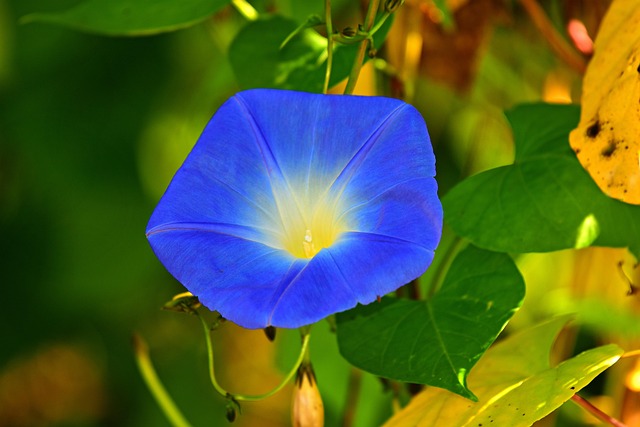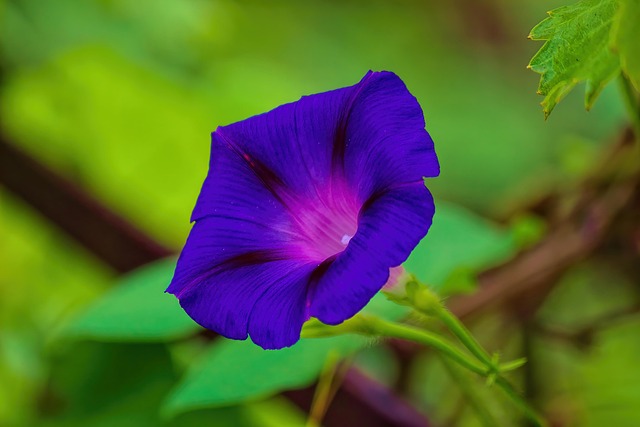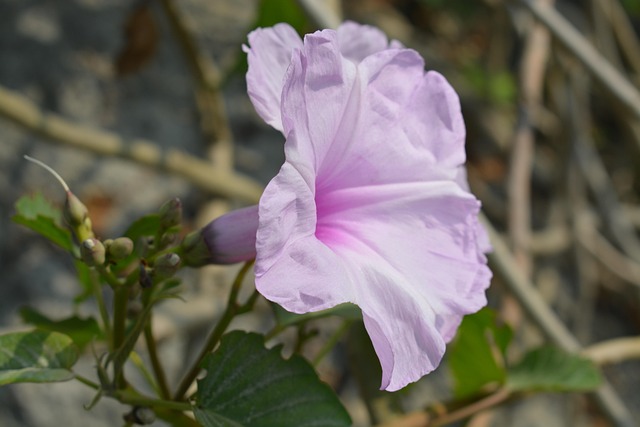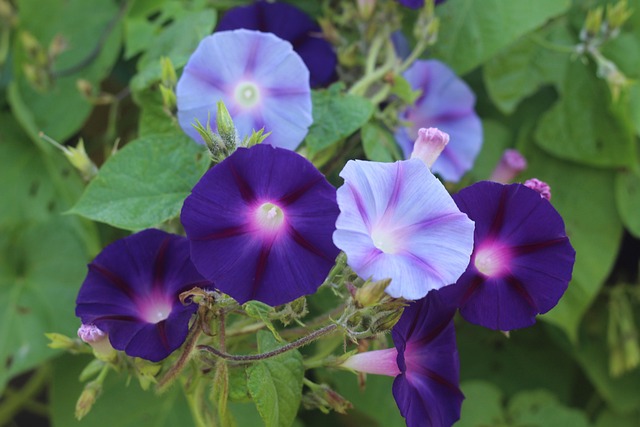Japanese morning glory, or asagao in Japanese, represents far more than just a beautiful summer flower. These vibrant climbing vines embody centuries of Japanese gardening culture, artistic expression, and philosophical reflection on life’s ephemeral beauty.
From the bustling morning glory markets of Tokyo to the quiet temple gardens where monks have cultivated these flowers for over a millennium, Japanese morning glories offer a unique window into Japan’s rich horticultural heritage.
What Makes Japanese Morning Glory Special

Japanese morning glories are exceptional because of their deep cultural significance and remarkable genetic diversity developed during the Edo period. Unlike morning glories grown elsewhere, Japanese varieties showcase an extraordinary range of colors, patterns, and forms that emerged from centuries of selective breeding and mutation.
The uniqueness lies in the “henka asagao” or mutant morning glories that became cultural phenomena during Japan’s Edo period. These unusual varieties, with their twisted petals, variegated leaves, and unusual colors, represent a gardening culture that celebrates both beauty and impermanence.
Historical and Cultural Background
History from Heian Period
Morning glories were first introduced to Japan during the Heian period (8th-9th centuries), arriving directly from China as medicinal plants rather than ornamental flowers. Initially valued for their laxative properties, these plants gradually found their way into Japanese gardens.
The transformation from medicine to art occurred gradually, as Japanese gardeners began appreciating the flowers’ ephemeral beauty and symbolic significance. The daily cycle of blooming at dawn and fading by afternoon perfectly embodied the Buddhist concept of impermanence.
Edo Period Morning Glory Boom
The true cultural explosion of morning glories occurred during the Edo period, with two major booms that swept through Japan:
| Period | Years | Characteristics |
|---|---|---|
| Bunka-Bunsei Boom | 1810-1830 | Focus on collecting different colors and varieties |
| Kaei-Ansei Boom | 1847-1861 | Emphasis on mutant varieties with unusual forms |
During these periods, morning glory cultivation became a national obsession. City dwellers, particularly in Edo (modern Tokyo), Osaka, and Kyoto, competed to grow the most unusual and beautiful varieties. The practice became so popular that it influenced art, literature, and social customs throughout Japan.
Flower Competitions and Contests
The Edo period saw the development of “hana awase” or flower competitions, where growers would display their prized morning glories at local temples and community spaces. These events were ranked using the traditional sumo wrestling ranking system called “banzuke,” creating printed lists that documented the best flowers and their cultivators.
These competitions fostered a spirit of innovation and artistic expression that led to the development of hundreds of unique varieties, many of which are still cultivated today.
The World of Mutant Morning Glories

What are Henka Asagao
Henka asagao, or mutant morning glories, represent one of Japan’s most unique contributions to horticulture. These varieties exhibit unusual characteristics such as:
- Twisted or ruffled petals
- Variegated leaves with white or yellow markings
- Unusual flower shapes including star-like forms
- Non-standard colors and patterns
- Climbing patterns different from typical varieties
Notable Mutant Varieties
The diversity of henka asagao became legendary during the Edo period. Some famous varieties included flowers with petals that resembled chrysanthemums, leaves that looked like cherry blossoms, and vines that grew in unusual spiraling patterns.
Modern scientific research has revealed that many of these mutations were caused by transposable elements or “jumping genes,” making Japanese morning glories valuable subjects for genetic research while maintaining their cultural significance.
Edo Period Breeding Techniques
Edo period gardeners developed sophisticated techniques for maintaining and propagating these unusual varieties:
- Selective seed collection from the most promising plants
- Environmental manipulation to encourage mutation
- Careful documentation of varieties and their characteristics
- Trading networks between cities to share rare varieties
These methods, combined with detailed illustrated books documenting different varieties, created a comprehensive system for preserving and developing morning glory culture.
Japanese Morning Glory Growing Guide
Basic Growing Methods
Japanese morning glories thrive in warm, sunny locations with well-draining soil. The traditional Japanese approach emphasizes:
Soil preparation: Create loose, fertile soil with good drainage. Japanese gardeners traditionally mix in organic matter such as leaf mold or aged compost.
Sowing timing: Plant seeds after the last frost date, typically late spring to early summer. Soak seeds overnight before planting to improve germination.
Support structures: Provide sturdy climbing supports such as bamboo poles, trellises, or traditional Japanese “andon shitate” cylindrical structures that resemble paper lanterns.
Japanese Training Methods
Traditional Japanese cultivation techniques focus on creating beautiful, controlled displays:
Container growing: Many varieties are grown in pots, allowing for better control over growth and easier display during competitions or festivals.
Pruning techniques: Regular pinching of growing tips encourages bushier growth and more flower production.
Water management: Morning glories prefer consistent moisture but not waterlogged conditions. Traditional watering occurs early morning or evening.
Seasonal Care
Japanese morning glory care follows a precise seasonal schedule:
| Season | Care Activities |
|---|---|
| Spring | Seed preparation, soil preparation, initial planting |
| Summer | Daily watering, support training, flower observation |
| Autumn | Seed collection, variety documentation, plant removal |
| Winter | Seed storage, planning for next year’s varieties |
Modern Ways to Enjoy Morning Glories

Morning Glory Markets and Summer Festivals
The most famous celebration of Japanese morning glory culture occurs at the Iriya Morning Glory Festival in Tokyo, held annually July 6-8. This traditional market features over 120 vendors selling approximately 120,000 morning glory plants.
Visitors describe the experience: “Colors and shapes of various kinds, it was fun to walk around and see the various morning glories for sale. There were many food stalls and it was fun to eat and walk around.”
Another festival-goer noted: “When purchasing morning glories, the shop staff consulted with me while looking at the colors of the morning glories that would bloom in the future.”
The festival’s official website at
provides current information about dates, vendors, and special events.
Home Gardening Applications
Modern Japanese gardeners continue traditional practices while adapting to contemporary spaces:
Urban gardening: Morning glories work excellently for vertical gardening in small spaces, providing natural air conditioning through evapotranspiration.
Educational gardens: Schools and community centers use morning glories to teach children about plant life cycles and traditional Japanese culture.
Therapeutic gardening: The daily ritual of caring for morning glories provides meditative benefits and connection to seasonal rhythms.
Art and Cultural Activities
Morning glories continue inspiring contemporary Japanese art and culture:
Photography: The ephemeral nature of morning glory blooms makes them popular subjects for photographers capturing mono no aware (the pathos of things).
Traditional crafts: Morning glory motifs appear in textiles, ceramics, and other traditional Japanese crafts.
Botanical illustration: The tradition of documenting varieties through detailed illustrations continues in modern botanical art.
References: For those interested in Japanese flower arrangement traditions, our guide to ikebana offers complementary insights:

Conclusion
Japanese morning glories represent a unique fusion of natural beauty, cultural heritage, and horticultural innovation that has captivated people for over twelve centuries. From their humble beginnings as medicinal plants to their starring role in Edo period garden culture, these flowers embody the Japanese aesthetic principle of finding profound beauty in transient moments.
Today’s gardeners can connect with this rich tradition by growing Japanese morning glory varieties, participating in local festivals, and appreciating the daily miracle of flowers that bloom with the dawn and fade with the setting sun. Whether grown in traditional containers or modern gardens, Japanese morning glories continue to teach us about patience, beauty, and the precious nature of each passing day.
The legacy of Japanese morning glory culture reminds us that gardening is not merely about producing beautiful flowers, but about cultivating a deeper understanding of nature, time, and our place within the endless cycle of seasons.


